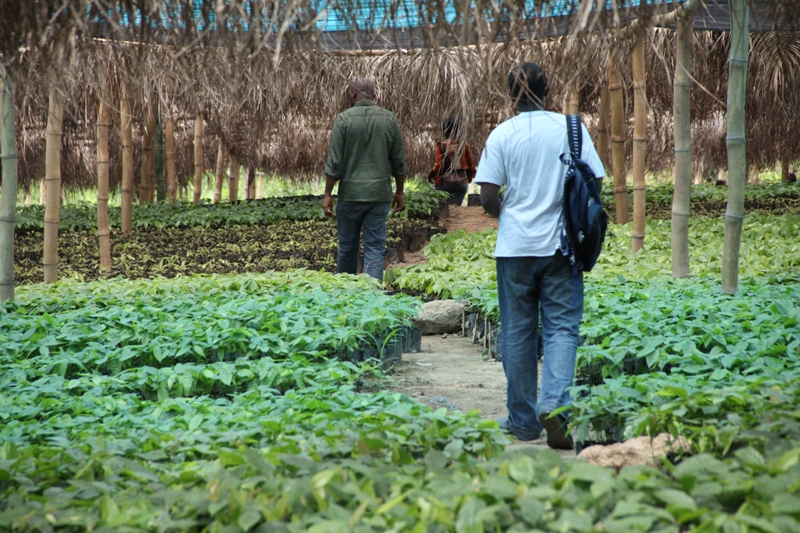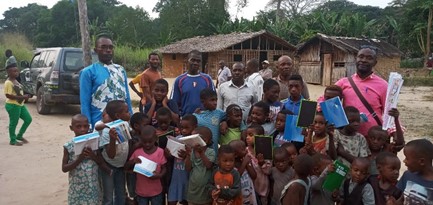Deploying livelihoods-enhancing options for REDD+: Improved agricultural systems, wildlife resources, community landscapes, and rural products
In this second part of a two-part blog series, George Akwah Neba, IUCN’s REDD+ Programme Officer, continues his discussion on secured livelihoods as a critical dimension of the rights-based approach and pro-poor oriented frameworks for REDD+.

Photo: Jan Willen Den Besten
IUCN is working with partners and government institutions to pilot and upscale livelihood enhancing options for reducing emissions from deforestation and forest degradation (REDD). Pilot initiatives undertaken in 14 landscapes across 7 countries – Cameroon, Ghana, Guatemala, Indonesia, Mexico, Peru and Uganda – are providing the framework for learning from, and policy inputs for, the design of livelihoods-oriented national REDD+ strategies. Traditional conservation policies and strategies often oppose livelihoods – which are viewed as a threat to conservation and sustainable forest management.
IUCN and partners have identified and are assessing or demonstrating a number of livelihoods options, and lessons and experiences are being integrated into the designs of national REDD+ strategies. Read about the first set of options here.
Options for improved agricultural production systems
Sustainable cocoa/climate smart cocoa: Sustainable cocoa production has emerged in Ghana and Guatemala as an important opportunity for regaining forest cover and increasing carbon stocks in cocoa farm systems within two predominantly cocoa-producing landscapes – Wassa Amenfi West landscape in Ghana and the Lachua Ecoregion in Guatemala. In Ghana, IUCN has been helping farmers assess the value and incentives for shifting to shade cocoa varieties versus full-sun varieties; and the advantage of increasing the forest cover of cocoa farms through mosaic restoration.
Participatory analytical assessments and more classical surveys were conducted to gain understanding and inform farmers of the advantages of shade cocoa, in terms of increased productivity, improved forest cover and resulting environmental services, improved economic gains and more. Agronomic and economic research conducted by IITA demonstrates the productivity and economic and carbon sequestration value of cocoa intercropping with trees through mosaic restoration approaches. It is therefore expected that this livelihood option would provide farmers the opportunity to earn premium prices from sales of shade grown cocoa (‘climate smart beans’), carbon credit from payments-for-ecosystem-services (PES) markets, income from sales of tree products and other co-benefits associated with the adoption of mosaic restoration in cocoa farms.
Afforestation/reforestation: Afforestation and reforestation have emerged as key livelihoods options in highly deforested and degraded landscapes in Ghana, Guatemala, Papua (Indonesia) and Uganda. Methods include natural regeneration, planting and management of woodlots and restoration of full landscapes such as in the Baliem Valley in Papua. The opportunities to link these efforts with ongoing national forest landscape restoration (FLR) programmes are considerable, and IUCN is working to establish such synergies.
Options for domestication/cultivation of wildlife resources of high and extensive economic and livelihood use
Domestication of wild NTFPs: In Cameroon, IUCN is working with national and landscape partners to pilot agroforestry approaches for the domestication or farming of wild resources of economic and livelihoods value. These products, largely harvested from nature, are becoming more and more difficult to find due to increased pressure and competition with external actors. Succeeding in producing these resources through agroforestry methods would not only reduce pressure on nature, but also become business opportunities for rural households.
Farming wildlife such as ruminants, grass cutters and snails: The raising of ruminants and other small animals is also one area of interest for communities. Ruminants provide protein/nutrition for households as well as cash income from sales of these products on the market. Rearing or domestication of some of these animals, otherwise sourced from the forests, is perceived as a way to reduce pressure on wild stocks and reduce unsustainable practices associated with hunting, such as bushfires and violations of hunting regulations.
Options for ecotourism oriented management and exploitation of community landscapes
Each of the landscapes in the seven countries has ecotourism potential that could be built up and promoted as livelihoods enhancing measures to sustainable forest management. Cameroon, Ghana and Guatemala already have some endeavours taking place with varying degrees of success. Such endeavours include community organised and coordinated sport hunting, kayaking, and eco-village initiatives among others. Ecotourism emerged as an option because of its potential for sustainable management of ecosystems and the sale of nature-based services. This is a powerful incentive for communities to engage in sustainable forest management. Community ecotourism is, however, still rudimentary, lacks support and investment, and poor community organisation structures challenge its development.
Options for improved processing and market access for rural products
Improving processing and market access is a cross-cutting option as it heavily influences the success of all other options, and is a powerful mechanism to engage communities in sustainable production systems. IUCN is working with other initiatives to pilot models for processing and market access as illustrated by an initiative led by IUCN partner A Rocha. They work on shea butter production by women’s groups in northern Ghana which benefits from private-community partnership arrangements that guarantee a profitable market for this community production. In Lachua Ecoregion, an organised cocoa processing and commercialisation model is also an inspiring example that could be built upon.
Lessons and experiences from ongoing IUCN and partners’ work shows that livelihoods and rights are effective entry points for REDD+ at the community level. Approaching REDD+ from this angle helps avoid the cumbersome exercise of selling REDD+ as a compensation mechanism. The livelihoods focus helps build sustainability as a principle of community livelihoods activities, rather than selling the uncertain vision of REDD+ as just a carbon business.




